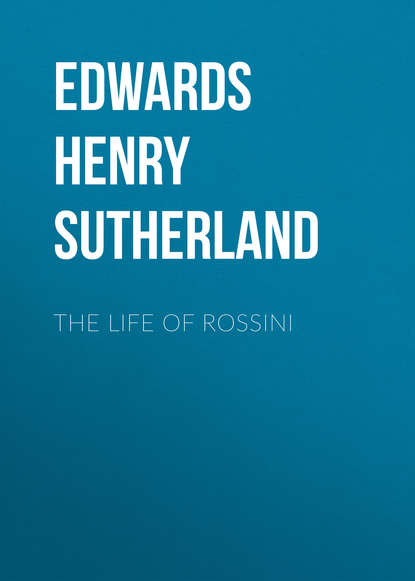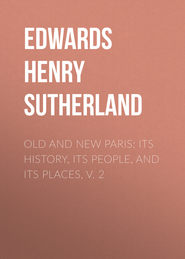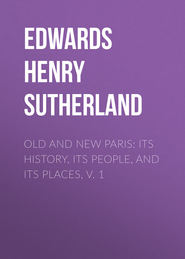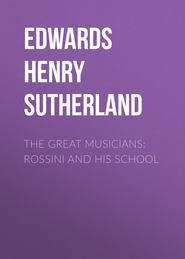По всем вопросам обращайтесь на: info@litportal.ru
(©) 2003-2024.
✖
The Life of Rossini
Настройки чтения
Размер шрифта
Высота строк
Поля
MOZART AND ROSSINI
NEW instruments have been introduced since Mozart’s time. It has become the fashion still farther to shorten recitatives; the chorus has been made more prominent than ever in Italian Opera, and Verdi gives it flowing melodies to sing as to a soloist of fifty-voice power. Nevertheless, in all essentials, no progress in the composition of dramatic music has been made since “Don Giovanni;” and if Mozart’s operas had been known in Italy when Rossini began to write, then, instead of saying that Rossini took this idea from Cimarosa and from Paisiello, that from Gluck, that from Haydn, it would be much simpler to say that he took all that was new in the construction of his works from Mozart.
Rossini could scarcely have studied Mozart’s works – certainly not their effect on the stage – when, in 1813, he produced “Tancredi;” in fact, “Tancredi” presents much less modern forms than the “Marriage of Figaro” and “Don Giovanni,” written a quarter of a century earlier. But it must be remembered that Rossini did not perfect his style until about 1816, the year of “Otello” and of the “Barber of Seville;” and in the meanwhile La Scala had represented “Don Giovanni” (1814), and with much greater success “Le Nozze di Figaro” (1815).
Mozart may have prepared the way for Rossini’s European success, and Rossini certainly profited in a direct manner by all Mozart’s reforms in the lyric drama. Still he may be said to have arrived independently of Mozart’s influence at many of Mozart’s results. Even in what passes specially for a reform introduced by Rossini, the practice of writing airs, ornaments, and all, precisely as they are to be sung, Rossini had been anticipated by Mozart, by Gluck, by Handel, by all the German composers. Nevertheless, it was not in deliberate imitation of the more exact composers of Germany, it was for the sake of his own music that Rossini made this important innovation, which no composer has since departed from.
Out of Germany Mozart’s operas only became known a very short time before those of Rossini. Mozart was at once appreciated by the Bohemians of Prague, but his success was contested, by the Germans of Vienna, and it may be said with only too much truth that his masterpieces met with no general recognition until after his death. Joseph II. cared only for Italian music, and never gave his entire approbation to anything Mozart produced, though some of the best musicians of the period, with Haydn and Cimarosa at their head, acknowledged him to be the greatest composer in Europe.
The Emperor thought there were “too many notes” in the “Entführung aus dem Serail,” in spite of Mozart’s assurance that there were “precisely the proper number.” The “Marriage of Figaro,” not much esteemed by the Court, was hissed by the Viennese public on its first production; while “Don Giovanni” itself, in spite of its success at Prague, was quite eclipsed at Vienna by the “Assur” of Salieri. Cimarosa in the meanwhile was idolised at Court. The Emperor Leopold, at the first representation of “Matrimonio Segretto,” encored the whole work, and loaded the composer with honours and riches; but he never really appreciated Mozart’s works.
The influence of a clique of hostile Italian musicians living at Vienna, also, no doubt, counted for something. In taking an important part in the establishment of German Opera, Mozart threatened to diminish the reputation of the Italian school. The “Entführung aus dem Serail” was the first blow to the supremacy of Italian Opera; “Der Schauspiel-direktor” was the second; and when, after the production of this latter work at the New German Theatre of Vienna, Mozart proceeded to write the “Nozze di Figaro” for the Italians, he simply placed himself in the hands of his enemies.
It cannot be said that in Italy Mozart’s recognition was delayed by mere national prejudice; but his works presented great executive difficulties; many of the pieces were too complex for the Italian taste, while in others too much importance was assigned to the orchestra, too little to the voices. Mozart, moreover, was not in the country to propose and superintend the production of his works, and the Italian composers, his contemporaries, thought, no doubt, that they did enough, in getting their own brought out.
Ultimately it was through Italian singers that both “Don Giovanni” and “Le Nozze di Figaro” became known throughout Europe; but Mozart’s two great operas, though written fully thirty years before Rossini’s best works, were not introduced in Italy, France, and England, until about the same time. It took Mozart upwards of a quarter of a century to make the journey from Vienna to London; whereas Rossini, from Rome and Naples, reached both London and Paris in three or four years.
CHAPTER V
ROSSINI’S REFORMS IN SERIOUS OPERA
WE have seen that when Rossini’s “Tancredi” was first brought out in London, Lord Mount-Edgcumbe did not know what to make of it, and thought Italian Opera was coming to an end; whereas, as far as that generation was concerned, it was only just beginning. “Tancredi” has, in the present day, somewhat of an old-fashioned, or rather, let us say, antique character. Many of the melodic phrases, by dint of fifty years’ wear, have lost their primitive freshness; and they are often decorated in a style which, good or bad, does not suit the taste of the present day. But it marks the commencement of the reforms introduced by Rossini into opera seria, and it is the first work by which he became known abroad. A very few years after its first production at Venice, “Tancredi” was played all over Europe.
To most opera goers of the present-day, the recitatives of “Tancredi” will appear sufficiently long – they are interminable compared with the brief recitatives by which Verdi connects his pieces. But before the time of “Tancredi,” dialogue in recitative may be said to have formed the ground-work and substance of opera; and many an opera seria consisted almost entirely of recitative broken here and there by airs for a single voice. The opera buffa was richer in concerted music; and Rossini, speaking broadly, introduced the forms of opera buffa into opera seria. For much declamation he substituted singing; for endless monologues and duologues, ensembles connected and supported by a brilliant orchestra. The bass singer was still kept somewhat in the background. But he had a part; his personality was recognised; and some of the amateurs of the old school pointed to him in “Tancredi” with prophetic eye, and sadly foretold that, having been allowed to make his first step, he would be gradually brought forward until, at last, he would stand prominently in the front – as he in fact did a very few years afterwards in Rossini’s “Mosè.”
Before “Tancredi” the bass took no part in tragic opera. Then, in addition to the new distribution of parts, the new arrangement of the dramatic scenes, the elaborate finale, the bright sonorous instrumentation, there were the charming melodies, there was the animation of the style, which, whatever the plan of the work, would certainly have sufficed to ensure it a large measure of success. All who heard the opera must, consciously or unconsciously, have felt the effect of Rossini’s admirable innovations; but what chiefly excited the enthusiasm of the public was the beauty of the melodies. All Venice sang the airs from “Tancredi,” the gondoliers made them into serenades; Rossini was followed by them wherever he went. It is said that they used even to be introduced in the law courts, and that the judges had more than once to stop the humming of “mi rivedrai, te revedro.” “I thought when they heard my opera,” said Rossini, “that the Venetians would think me mad. But I found that they were much madder than I was.”
It was indeed with some fear and trepidation that Rossini witnessed the preparations for the first performance of “Tancredi.” He had not met the Venetian public since that affair of the lamp-shade accompaniment, into the humour of which they had positively refused to enter; and it was not at all certain that by way of a practical joke on their side, they would not hiss a work which the composer meant this time to be enthusiastically applauded. The manager of the Mosè, moreover, was now an enemy of Rossini, and, independently of that, would certainly not be sorry to hear of a failure at the “other house.” The Fenice, then, was full, the musicians of the orchestra were at their posts, the time for commencing the overture had arrived, and still Rossini was nowhere to be found.
It was at that time the custom in Italy for the composer of a new opera to preside at its representation three successive times; but Rossini seemed determined to escape at least one of these trial performances.
However, he intended the overture as a sort of peace-offering. It was begun in his absence under the leadership of the first violin; and the first allegro was so much applauded that Rossini at once felt justified in leaving his hiding place by the entrance to the orchestra and taking his seat on the conductor’s chair. The crescendo, a means not invented by Rossini, but employed by him more persistently and with more success, than by any other composer, produced an effect which was repeated again and again in subsequent works, and never once too often. In fact, the whole of the animated and rather joyous prelude to what, if not a very serious opera, is at least an opera on a very serious subject, was received with expressions of delight.
No operatic overture was at one time more popular than that of “Tancredi.” Perhaps it is our fault as much as that of the music, if it appears a little old-fashioned now. Certainly it is trivial in character. It does not fill the mind with thoughts and visions of noble deeds; nor does it present the slightest picture of the crusades as a modern programme-overture (with the aid of the programme) might do. But it caused the Venetians to forget the affair of the lamp-shade accompaniment; it predisposed them to enjoy the melodic beauties of which “Tancredi” is full; and, reduced for the piano-forte, it became, during only too long a period, an effective show-piece for young ladies.
The crescendo, which pleased the audience in the overture, must have delighted them in the concerted finale, where it is reproduced on a more extended scale. This effect is said to have been suggested to Rossini by a similar one in Paisiello’s “Re Teodoro.” But the great maker of crescendo movements before Rossini was Mosca, who circulated numerous copies of one of his pieces containing crescendo effects, by way of proving his exclusive right to manufacture them. He was very indignant with Rossini for interfering with what he had accustomed himself to regard as his own private monopoly, and always declared that he, Mosca, was the true author of Rossini’s celebrated crescendi.
Considering the very delicate relations subsisting between Rossini and the Venetian public, it must somewhat have alarmed him, when, the day before “Tancredi” was to be produced, he found that Madame Malanotte, the representative of the young hero, was dissatisfied with her first air.
Probably Madame Malanotte was difficult to please. At all events, it was necessary to please her; and Rossini went away from the theatre wondering what he could improvise for her in place of the cavatina she had rejected.
He went home to dinner – even the composer who has, at a moment’s notice, to satisfy the caprices of a prima donna, must dine – and told his servant to “prepare the rice;” fried rice being the Venetian substitute for macaroni, oysters, soup, no matter what first dish. During the few minutes necessary for frying and serving the rice, Rossini had begun to note down an air. The beautiful melody afterwards known as “Di tanti palpiti” had occurred to him; and this he had made the principal subject of the air to be sung by the fortunate Madame Malanotte on making her entry. The whole of the cavatina is beautiful; and if, as Stendhal says, the air of the allegro was borrowed by Rossini from a Greek hymn (Lord Mount Edgcumbe says that it is taken from some Roman Catholic service), then we ought to be very glad that Rossini did borrow it.
But no one who has ever heard the very primitive music of the Greek church will believe that the melody of “Di tanti palpiti” formed any part of it – certainly not in its present shape and setting. Berlioz is said to have admired the music of the Russian church; but then the Russians admired the music of Berlioz, and it is doubtful whether Berlioz admired “Di tanti palpiti.”
“It is said at Venice,” writes Stendhal, “that the first idea of this delicious cantilena, which expresses so well the joy of meeting after a long absence, is taken from a Greek litany; Rossini had heard it sung a few days before at vespers in the church of one of the little islands of the lagoons of Venice.”[6 - M. Azevedo’s idea on the subject is certainly the best. “Since its production,” he says, “on the stage and in the universe it has been made the subject of a canticle for the Catholic Church, like all other successful airs. But a litany before the air and a canticle after the air are not the same thing.” M. Azevedo also rejects the rice.]
“Aria dei rizzi,” however, was the name popularly given to it; and wherever the first idea came from, the melody, as it now exists, is eminently Rossinian in form and style. How many great singers have sung this lovely air, beginning with the celebrated Pasta, who played the part of Tancredi as long as she remained on the stage, and whose favourite piece, after she had left it, to appear only at concerts, was still “Di tanti palpiti?” It has been seen that Madame Malanotte was the original Tancredi at Venice; Madame Pasta was the first representative of the character in France and England, and Pisaroni, Malibran, and Madame Viardot-Garcia afterwards distinguished themselves in the same part.
The most brilliant Amenaide ever heard was probably Madame Sontag, who appeared in that character in 1829 to Malibran’s Tancredi.
CHAPTER VI
ROSSINI’S REFORMS IN COMIC OPERA
AS Rossini found the opera seria of his day too serious, so he found the opera buffa too broadly comic. He was accused of treating tragic subjects melodramatically – which meant that he made them interesting. In dealing with comic subjects he took care to keep above the level of farce, his general tone being that of comedy, into which he now and then, but not often, introduced a touch of sentiment (“Languir per una bella” in “L’Italiana,” “Ecco ridente il cielo” in “Il Barbiere”).
The old opera buffa, with its separate set of characters and singers, and its own separate style, musical as well as dramatic, died out under the influence of Rossini’s innovations. It is said to have been very fine, by those who liked it; but apparently Rossini did not like it, for after trying his hand at a few specimens (of which the notorious little operetta or farza with the lamp-shade accompaniment seems to have been the last) he abandoned it, as after a single trial (Velluti in “Aureliano in Palmira”) he abandoned the sopranists.
If Rossini ever wrote an opera seria in the old style, it must have been that work of his early youth, “Demetrio e Polibio,” of which all that seems to be known is, that it was composed in 1809 for the Mombellis, and produced at Rome in 1812.
It must have seemed strange and rather awful to some obstinate habitués (and habitués are often as obstinate as habit itself) that the same singer should come before them one night as Moses, and the next as Doctor Bartholo, one night as Figaro, and the next as Assur in “Semiramide.” At the same time they appear to have been annoyed with Rossini both because in his serious works he was not more severe, and because in his comic works he was not more grotesque.
The fact is, Rossini rendered both styles more natural, more like life, as far as life can be represented in opera, and certainly more dramatic.
In “L’Italiana in Algeri” we see only the first essay in the style which was to be brought to perfection in “Il Barbiere” and “Cenerentola;” but “L’Italiana” was the forerunner of these works, just as “Tancredi,” in the serious style, was the forerunner of “Otello” and “Semiramide.”
“L’Italiana in Algeri,” like “Tancredi,” was composed for Venice; this time neither for the San Mosè nor the Fenice, but for the San Benedetto. The principal part was written for Madame Marcolini, who again, as in “L’Equivoco Stravagante,” and “La Pietra del Paragone,” was provided with a brilliant rondo finale.
In the concerted finale of the first act the prolonged crescendo was found as effective as the same device had proved in “Tancredi.” Rossini had now adopted his crescendo, never to forsake it; and if he was faithful to it, it certainly was faithful to him, and never once deceived him.
The recitatives in “L’Italiana in Algeri,” as in “Tancredi,” are still rather long. The dramatic progress, too, in “L’Italiana” is slow, and the acts, as in all Rossini’s two-act operas – that is to say, all his important Italian operas, with the exception of “Otello” – last a prodigious time.
It must be remembered that when these operas were written it was the custom in Italy to give a divertissement, or even a long ballet, between the acts. As to the lengthiness of the recitatives, that was an affair of very little importance. No one was obliged to listen to them, and private conversation took place between the pieces, as public dancing took place between the acts.
Not only recitatives, but inferior airs, were neglected in this manner. If Tancredi’s air was called “Aria dei rizzi,” because it was composed while rice was being cooked, Berta’s air in “Il Barbiere” got to be known as the “Aria di sorbetto,” because people used to eat ices while it was being sung.
Rossini, no doubt, effected a reform in the conduct of his audiences as well in that of his dramas. The public were quite right not to listen to interminable recitatives; and when Rossini shortened his, and gave them a more dramatic character, at the same time increasing the number and variety of musical pieces in each act, he soon gained the full attention of his audience; after which, one excuse at least for being tedious had disappeared.
The worst of it was that, almost as soon as Rossini had brought the Italian public to listen to his operas from beginning to end, he ceased to write. “Il Barbiere” was composed in 1816, and he never gave Italy a note after “Semiramide” in 1823.
The moment has now arrived for recording an anecdote. It is not pleasant to tell it for the five hundredth time; but a place for the most celebrated of all the Rossini anecdotes must somewhere be found, and it belongs to the year 1813, of which we take leave with the present chapter.
It was in the eventful year, then, of 1813 – the year of “Il Figlio per Azzardo,” with its obbligato accompaniment for lamp-shades, of “Tancredi,” and of “L’Italiana in Algeri” – that Rossini was writing one morning in bed, when the duet on which he was engaged fell from his hands.
“Nothing easier,” an ordinary composer would say, “than to pick it up again.”
“Nothing easier,” said Rossini, “than to write a new one in its place.”
Rossini would not get out of bed for a mere duet. He set to work and composed another, which did not resemble the original one in the least.
A friend called. “I have just dropped a duet,” said Rossini, “I wish you would get it for me. You will find it somewhere under the bed.”
The friend felt for the duet with his cane, fished it out, and handed it to the composer.
“Now which do you like best?” asked Rossini; “I have written two.”
He sang them both. The friend thought the character of the first was most in keeping with the dramatic situation. Rossini was of the same opinion, and decided to turn the second duet into a trio.









